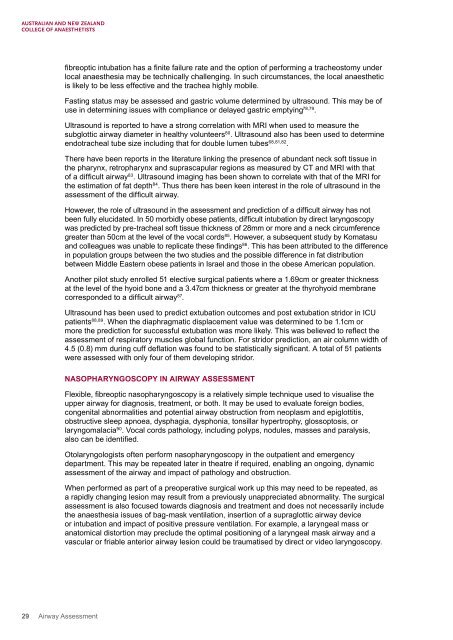Airway Assessment
2cKbSEQ
2cKbSEQ
You also want an ePaper? Increase the reach of your titles
YUMPU automatically turns print PDFs into web optimized ePapers that Google loves.
fibreoptic intubation has a finite failure rate and the option of performing a tracheostomy under<br />
local anaesthesia may be technically challenging. In such circumstances, the local anaesthetic<br />
is likely to be less effective and the trachea highly mobile.<br />
Fasting status may be assessed and gastric volume determined by ultrasound. This may be of<br />
use in determining issues with compliance or delayed gastric emptying 78,79 .<br />
Ultrasound is reported to have a strong correlation with MRI when used to measure the<br />
subglottic airway diameter in healthy volunteers 80 . Ultrasound also has been used to determine<br />
endotracheal tube size including that for double lumen tubes 68,81,82 .<br />
There have been reports in the literature linking the presence of abundant neck soft tissue in<br />
the pharynx, retropharynx and suprascapular regions as measured by CT and MRI with that<br />
of a difficult airway 83 . Ultrasound imaging has been shown to correlate with that of the MRI for<br />
the estimation of fat depth 84 . Thus there has been keen interest in the role of ultrasound in the<br />
assessment of the difficult airway.<br />
However, the role of ultrasound in the assessment and prediction of a difficult airway has not<br />
been fully elucidated. In 50 morbidly obese patients, difficult intubation by direct laryngoscopy<br />
was predicted by pre-tracheal soft tissue thickness of 28mm or more and a neck circumference<br />
greater than 50cm at the level of the vocal cords 85 . However, a subsequent study by Komatasu<br />
and colleagues was unable to replicate these findings 86 . This has been attributed to the difference<br />
in population groups between the two studies and the possible difference in fat distribution<br />
between Middle Eastern obese patients in Israel and those in the obese American population.<br />
Another pilot study enrolled 51 elective surgical patients where a 1.69cm or greater thickness<br />
at the level of the hyoid bone and a 3.47cm thickness or greater at the thyrohyoid membrane<br />
corresponded to a difficult airway 87 .<br />
Ultrasound has been used to predict extubation outcomes and post extubation stridor in ICU<br />
patients 88,89 . When the diaphragmatic displacement value was determined to be 1.1cm or<br />
more the prediction for successful extubation was more likely. This was believed to reflect the<br />
assessment of respiratory muscles global function. For stridor prediction, an air column width of<br />
4.5 (0.8) mm during cuff deflation was found to be statistically significant. A total of 51 patients<br />
were assessed with only four of them developing stridor.<br />
NASOPHARYNGOSCOPY IN AIRWAY ASSESSMENT<br />
Flexible, fibreoptic nasopharyngoscopy is a relatively simple technique used to visualise the<br />
upper airway for diagnosis, treatment, or both. It may be used to evaluate foreign bodies,<br />
congenital abnormalities and potential airway obstruction from neoplasm and epiglottitis,<br />
obstructive sleep apnoea, dysphagia, dysphonia, tonsillar hypertrophy, glossoptosis, or<br />
laryngomalacia 90 . Vocal cords pathology, including polyps, nodules, masses and paralysis,<br />
also can be identified.<br />
Otolaryngologists often perform nasopharyngoscopy in the outpatient and emergency<br />
department. This may be repeated later in theatre if required, enabling an ongoing, dynamic<br />
assessment of the airway and impact of pathology and obstruction.<br />
When performed as part of a preoperative surgical work up this may need to be repeated, as<br />
a rapidly changing lesion may result from a previously unappreciated abnormality. The surgical<br />
assessment is also focused towards diagnosis and treatment and does not necessarily include<br />
the anaesthesia issues of bag-mask ventilation, insertion of a supraglottic airway device<br />
or intubation and impact of positive pressure ventilation. For example, a laryngeal mass or<br />
anatomical distortion may preclude the optimal positioning of a laryngeal mask airway and a<br />
vascular or friable anterior airway lesion could be traumatised by direct or video laryngoscopy.<br />
29 <strong>Airway</strong> <strong>Assessment</strong>


